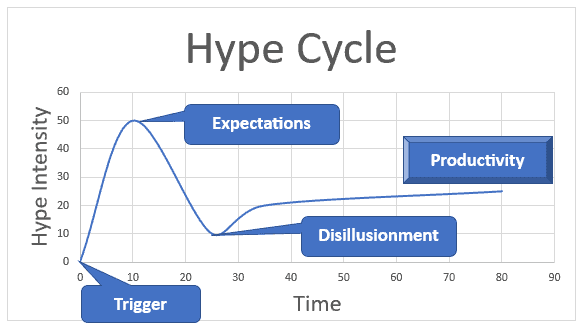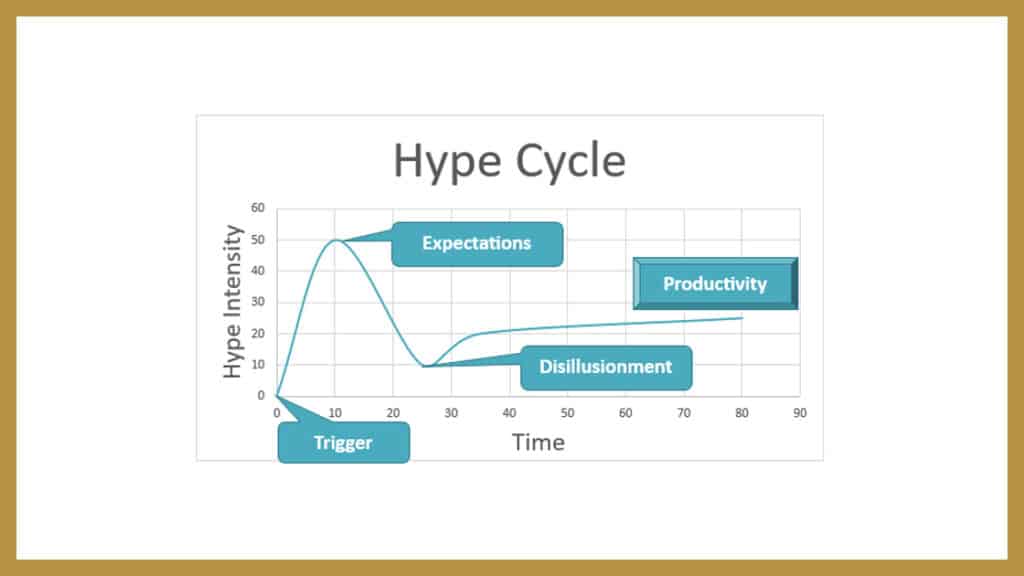At first glance, food fraud may not seem as hot as a few years ago, but the activities are logically, methodically, and optimally maturing along the ‘hype cycle.’ The melamine and horsemeat incidents were hype triggers, and we are now past the ‘Peak of Inflated Expectations’ in the ‘Scope of Enlightenment.’
When reviewing food fraud prevention and looking at the food industry and food safety management systems, it seems that the Global Food Safety Initiative (GFSI) is also moving along the ‘hype cycle.’ Several years ago, GFSI seemed to be one of the food industry’s most active and buzz-filled activities. The annual conferences in Beijing, Barcelona, Tokyo, and Houston were some of the most significant food industry business events. The new GFSI projects were changing the face of the food industry, including adopting the food fraud concepts (e.g., the 2014 GFSI Food Fraud Position Paper, the new requirements in the 2017 version of the GFSI Benchmarking Document, and the 2018 GFSI Food Fraud Technical Document.)
Looking back at the development of the GFSI-related food safety management systems, there was tremendous focus and change in the food industry. A key accomplishment was creating a central benchmark that was nearly universally adopted. Also, GFSI inspired an intense focus on food safety, even resulting in job titles shifting from ‘Chief Quality Officer’ to ‘Chief Food Safety Officer.’
While there is probably less ‘hype’ or ‘buzz’ about GFSI now, it is a testament to the continued maturing of the implementation. Applying the ‘hype cycle’ concepts, there is a natural and expected calming of activities as the initial hype shifts to real work and the adoption of standard operating procedures. The next step along the way is supporting and refining the ‘Plateau of Productivity.’
Food Fraud Prevention is Maturing Along the ‘Hype Cycle’
A research theory was developed to explain the adoption of new ideas or technology. In 1995, Jackie Fenn, a researcher at Gartner Incorporated, published the Hype Cycle Methodology (Figure). Over time, a new idea often starts applying or adopting new technology to meet the problem. For food fraud, the technology hype was food authenticity testing to address incidents such as Sudan red carcinogen colorant, melamine in infant formula, horsemeat in beef, and the new regulatory and industry compliance requirements. Other product protection hype cycles would be mass serialized codes, RFID, QR codes tracing the product back to a field, and blockchain.
After the ‘technology trigger,’ there is the ‘Peak of Inflated Expectations.’ At this point, there is an amazement that the new technology will solve previously insurmountable problems. The ‘hype cycle’ peaks, and then reality sets in, leading to a drop to the ‘Trough of Disillusionment.’ With very few exceptions, there are no magic solutions. This high and then low are important since they help bring about technological innovation and then an intense focus on the root cause of the problem. This awareness is the ‘Scope of Enlightenment.’ After this, the final stage is the ‘Plateau of Productivity’ and the evolution of an ever-increasing efficient and effective strategy.

Food Fraud from the ‘Scope of Enlightenment’ to the ‘Plateau of Productivity
The GFSI-related Food Safety Management System activities are in the final and ongoing stage, the ‘Plateau of Productivity.’ The GFSI activities started around 2002 and really accelerated from around 2005 to 2009. After the core food safety concepts were formed, it was natural for GFSI to focus on related areas such as food safety culture and food fraud. In 2012, the GFSI Board of Directors created the GFSI Food Fraud Think Tank to review ‘what’ food fraud is. Spurred by the horsemeat incident (pun intended) the project focus shifted from ‘what is food fraud’ and ‘should GFSI address food fraud directly’ to ‘how GFSI will address food fraud.’ The project was completed with the GFSI Food Fraud Position Paper publication in 2014. This position paper stated that the GFSI benchmarking document would include food fraud prevention compliance requirements in the new standard due to be released in 2017 and required in 2018.
In the 2009 to 2017 timeframe, the food fraud topic did not need any more hype. During that time, almost every food industry association conducted numerous food authenticity and food fraud prevention projects and events worldwide. The GFSI-related requirements effectively focused the work and created a common scope of activities. Since the GFSI food safety management system was being nearly universally adopted worldwide, it made sense for food fraud systems to adopt the GFSI scope.
A year after the 2018 GSFI details were required, there seemed to be a calming of activities and a steady movement from the ‘Trough of Disillusionment’ (e.g., ‘there are no magic solutions,’ and ‘the food fraud prevention testing is not food safety testing volume x2’) to the ‘Scope of Enlightenment’ (e.g., a shift in focus from risk to vulnerability, and from migration to prevention, and the need for an over-arching management system rather than on-off responses.). Then, in the midst of that shift, COVID hit, and there was a delay in industry-wide proactive projects from 2020 to 2022. While the world economy is still in a state of flux (e.g., inflation, Ukraine-Russia, shift to electric vehicles, shift from retail to product delivery, etc.), there is seemingly an awareness of the need for over-arching management systems. Food fraud prevention processes are poised to restart the progress of creating and implementing management systems. This activity will help shift food fraud to the ‘Plateau of Productivity.’
Essentially, food fraud prevention is nearing an inflection point where the hype and buzz are turning into just everyday, routine activities. Originally, quality management had a similar hype and buzz. Over time, quality management has just integrated into standard operating procedures. Over time, quality management has become a universally adopted topic that is inherent in good business practices. With a bit of guidance and effort, fully functioning and effective food fraud prevention will just become an everyday, routine activity as well.
Takeaway Points
- While food fraud may not seem to have the hype or buzz of a few years ago, the activities are logically, methodically, and optimally maturing along the ‘hype cycle.’
- The Global Food Safety Initiative (GFSI) is also seemingly shifting from hype or buzz to ongoing management activities that are becoming just routine standard operating procedures.
- Food fraud prevention has been evolving through the hype cycle. It is poised to move to the ‘Plateau of Productivity,’ which will mature into management systems and standard operating procedures.

